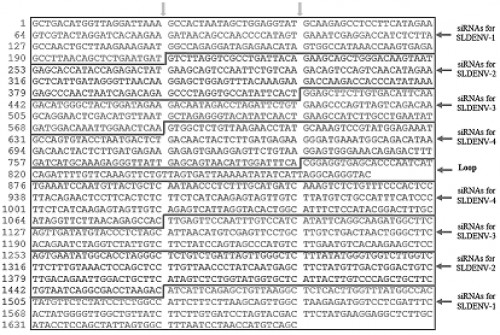Vol. 3, Issue 1, Part A (2016)
Engineering lhRNA based molecule to interfere replication of dengue virus in transgenic Aedes aegypti mosquitoes: Bioinformatics approach
Author(s): Sujeewa Sampath LD, Ranil Samantha Dassanayake, Kajan M, YI Nilmini Silva Gunawardena
Abstract: As a preliminary step towards the development of transgenic Aedes aegypti mosquito’s resistance to Sri Lankan dengue viruses (SLDENV), the identification of previously unpublished DNA sequence of the construct, AeCPA/Mnp+/i/Mnp-/svA, was done using bioinformatics tools. Furthermore, a long hairpin RNA (lhRNA) molecule effective against all four SLDENV serotypes was designed. If this lhRNA molecule to be cleaved by dicer at the correct site, the 100% of siRNA molecules produced are going to be effective against each serotype of SLDENV, on the contrary, if it is to be cleaved at random sites, which is the worst case, 52.63% of total siRNA molecules produced are going to be effective against each SLDENV serotype. In addition, an alternative promoter sequence, Ae. aegypti vitellogenin A1 (AeVtA), and a construct functionally similar to MosI helper plasmid, pKhsp82MOS (commercially unavailable) used in micro injection procedure of Ae. aegypti were also proposed in this study.
Related Graphics: Click here for more related graphics

Fig.: The designed effector lhRNA molecule in this study. The construct showing different regions of lhRNA made up of siRNAs specific to different dengue virus serotypes (C), and the position 1 to 798-nt of the sequence is the region that corresponds to positive (+) strand of the stem structure, the position 799 to 874 is the region that corresponds to loop structure and the position 874 to 1672 is the region that corresponds to negative (-) strand sequence of the stem structure of lhRNA molecule. The spaces in the figure indicated by two arrows (at the top of the figure) are the sites of lhRNA molecule that are cleaved by the dicer enzyme and the regions between spacer are the designed siRNA sequences containing 21 nucleotides.
Pages: 01-09 | 2383 Views 114 Downloads
How to cite this article:
Sujeewa Sampath LD, Ranil Samantha Dassanayake, Kajan M, YI Nilmini Silva Gunawardena. Engineering lhRNA based molecule to interfere replication of dengue virus in transgenic Aedes aegypti mosquitoes: Bioinformatics approach. Int J Mosq Res 2016;3(1):01-09.







